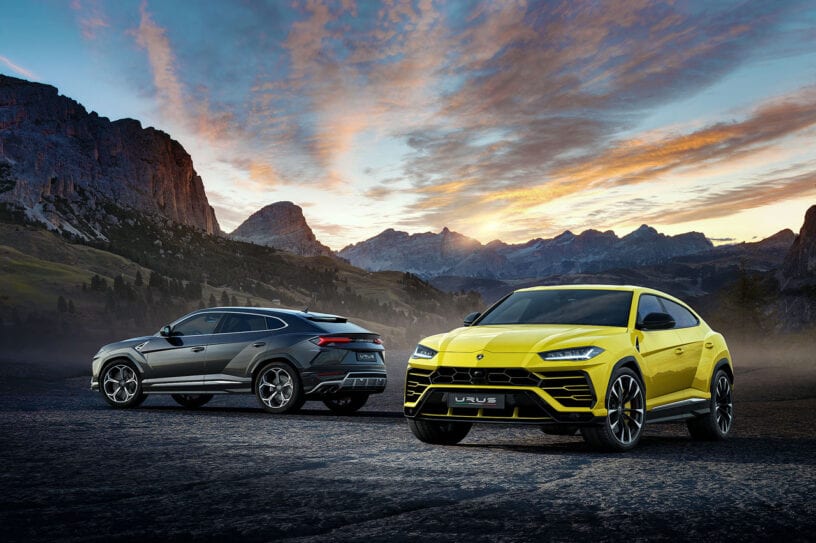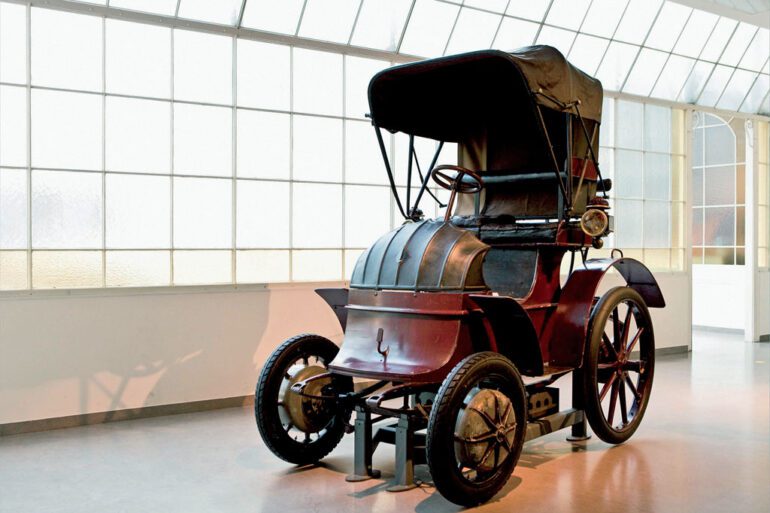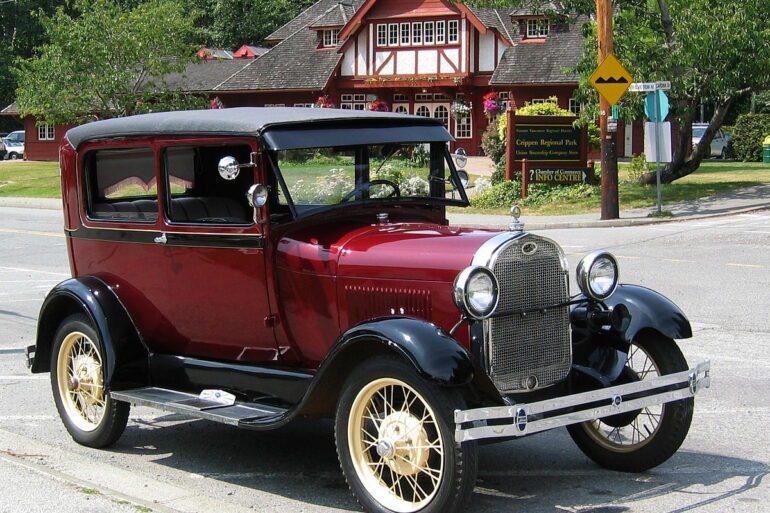Most Beautiful Cars of the 1950s
Updated September 2023 by Eduardo Zepeda

Beautiful silhouettes and a raw driving experience made these the best sports cars of the decade
About Our Selections
The 1950s was a transformative decade for the automotive world, marked by post-war optimism, innovation, and a rekindled love affair with the open road. During these years, some of the most iconic sports cars ever produced roared to life, leaving an indelible mark on the industry and the hearts of enthusiasts.
In this journey back in time, we'll explore the dazzling era of the 1950s, a period that birthed legendary sports cars, blending performance, style, and a sense of unbridled adventure. From gleaming Italian thoroughbreds to American muscle and British elegance, the 1950s had it all.
1951 Jaguar C Type
A motorsport legend
Why We Picked It:
The history of the Jaguar C-Type in motorsports is second to none. Only a select few can say they were responsible for introducing ground-breaking technology that not only helped them win races but would eventually make its way into production cars, greatly enhancing their safety. Not many automobiles can make the same aesthetic claim.
Jaguar's attempt at motorsport glory began the year before its 1951 debut. After the XK120's promising performance in the 24 Hours of Le Mans, Jaguar set out to make it lighter and more aerodynamic.
The ensuing C-Type ('C' for 'Competition') enclosed the XK120's mechanicals in a tubular steel frame and covered it with a more aerodynamic aluminum skin. The 3.4-liter straight-six engine generated 205 horsepower, more than the standard XK120 motor.
The modifications paid off, as the C-Type won its first competitive race, the Le Mans. Peter Walker and Peter Whitehead won the race by nine laps in the third C-Type.
Specifications:
Price: $1,700,000-$4,250,000
Engine: 3.4L Inline-Six
Power: 205 hp
Torque: 195 lb-ft
Transmission: 5-Speed Manual
Curb Weight: 2,130 lbs
Highlights:
The 16-gauge tubular design of the C-Type, with drilled channel-section members and triangulated support, replaced the steel ladder-type frame of the XK120.
Malcolm Sayer, an aerodynamicist, created a curved aluminum body to cover this new chassis. He left a minimum of clearances to give a small frontal area.
Learn More:
1958 Lotus Elite
Simply revolutionary
Why We Picked It:
The Lotus Elite was an excellent example of a genuinely driver-oriented offering. The world’s first fiberglass monocoque production car had a stressed-skin fiberglass unibody.
The revolutionary Elite body uses fiberglass and fiberglass-reinforced plastic to form a monocoque tub. Just five large pieces form the complete car. The only structural metal is used in the front engine subframe and a roll-hoop, which also provides the jacking points and attachments for the doors.
The monocoque material comes at a tradeoff as the fiberglass likes to flex, and early versions of the Elite tended to crack around the suspension pickup points. The near-absence of metal within the body provides an extremely lightweight, nimble car. The Coventry-Climax FWE engine offers ample power and is seldom seen in other road cars.
The unique construction made the Elite solid and light, allowing it superb aerodynamics (with a drag coefficient of just 0.29). Lotus adapted much of its grand prix racing technology into the Elite. Beyond the weight, the Elite offered four-wheel independent suspension, discs all around (including inboard rear brakes), and a very low aerodynamic drag at 0.29 Cd.
Specifications:
Price: $90,000
Engine: 1.2L Inline-Four
Power: 95 hp
Torque: 75 lb-ft
Transmission: 4-Speed Manual
Curb Weight: 1,420 lbs
Highlights:
Compared to the other sports cars of the era, the Elite was ahead of its time. A heavy inclusion of race-inspired technology made both Lotus and owners of the car soon realize the costs involved
In 1960, Lotus released an SE model with twin SU carburetors, a new exhaust, an XF manual transmission, Lucas P700 headlights, and a silver-painted roof.
Learn More:
1957 XKSS
A street-legal race car from the 1950s
Why We Picked It:
The XK-SS is the limited-edition road-going version of the Le Mans-winning D-Type race. Most changes to the car were made for comfort and safety purposes. The XK-SS has a new and improved windscreen, a soft top that folds down, a door on the passenger side, a baggage rack, and upgraded luxury inside fixtures.
Several completed and partially completed D-types remained unsold at Jaguar's Browns Lane plant after the company withdrew from competition at the end of the 1956 season. Sir William Lyons decided to convert some road-going specs to recuperate some of the investment invested in creating these underutilized chassis and capitalize on the lucrative American market for high-performance European sports cars.
The fundamental D-type structure was tweaked only slightly by adding a door on the passenger side, removing the bulky fin behind the driver's seat, and doing away with the partition between the front and rear seats. In addition, changes were made for cosmetic, comfort, and legal reasons. The powertrain of the Jaguar XK-SS comprised a 3.4-liter inline six with three Weber carburetors, churning out 250 horsepower and 242 lb-ft of torque. The engine was mated to a four-speed manual gearbox.
Specifications:
Price: $13,000,000
Engine: 3.4L Inline-Six
Power: 250 hp
Torque: 242 lb-ft
Transmission: 4-Speed Manual
Curb Weight: 2,030 lbs
Highlights:
With a 0–60 mph time of around 5 seconds and a top speed of 150 mph, the XKSS had exceptional performance. The car's lightweight magnesium alloy body and powerful six-cylinder engine made this possible.
Some upgrades to make the XKSS road-legal included a full-width, chrome-surrounded windscreen; side screens were added to both driver and passenger doors; and a rudimentary, folding fabric roof was added for weather protection.
Learn More:
1957 BMW 507
The quintessential German roadster
Why We Picked It:
Between 1956 and 1959, Albrecht von Goertz created the stunning two-door, two-seater convertible known as the BMW 507 Roadster.
The idea came from Max Hoffman, an importer of the German brand in the United States in the post-war era, with the firm determination to relaunch the brand with a car that could rival the Mercedes-Benz 300 SL and compete with locals like the Ford Thunderbird and the Chevrolet Corvette.
It was a robust car because, despite its contained dimensions and having beautiful bodywork sculpted in aluminum, it weighed 2,822 pounds. Its long, sharp nose, voluptuous curves, and abundance of chrome gave it a particular sense of elegance.
The car's proportions were classic roadster, with a long hood that housed the engine and a short rear deck, creating a visually balanced and sporty profile.
A naturally aspirated, aluminum, 3.2-liter OHV V8 engine with two double-barrel Zenith carburetors provided 150 horsepower at the heart of the 507 vehicle.
Specifications:
Price: $50,0000-$230,000
Engine: 3.2L V8
Power: 140 hp
Torque: 163 lb-ft
Transmission: 4-Speed Manual
Curb Weight: 2,822 lbs
Highlights:
The BMW 507 was elegant and sophisticated, featuring flowing lines, graceful curves, and a harmonious overall design.
The 507 featured clean, uncluttered lines and minimalistic ornamentation. It also featured a luxurious and well-appointed interior with high-quality materials, leather upholstery, and a stylish dashboard with elegant instrumentation.
Learn More:
1953 Porsche 550
A race-winning legend for the road
Why We Picked It:
The 550 Spyder was Porsche's answer to the necessity for a race car in the roadster class when production cars could no longer win. The third 550 prototype—the first 550 to compete—won the Nürburgring Eifel Race in 1953. Actor James Dean's untimely death was linked to the 550 Spyder since he was driving a brand new model when he crashed it on a California freeway. The 550 Spyder had a long and successful run, with only 90 units produced.
The Porsche 550 was the company's first mass-produced racing vehicle. The vehicle met all requirements for legal street use and could be driven to and from the track. Ernst Fuhrmann designed a one-of-a-kind engine just for it. It was a four-cylinder double-overhead-camshaft (DOHC) boxer engine with four camshafts, similar to the Porsche type 360 design for Formula 1, generating 110 horsepower.
The Fuhrmann 1500 shared zero similarities with the 356's "regular" 1500 cc engine. Compared to the pre-war Volkswagen design, which was also a Porsche design, the 4-cam Porsche engine produced twice as much power.
Specifications:
Price: $500,000-$10,000,000
Engine: 1.5L Flat-Four
Power: 110 hp
Torque: 89 lb-ft
Transmission: 4-Speed Manual / 5-Speed Manual
Curb Weight: 1,300 lbs
Highlights:
In 1956, the 550 evolved into a more powerful 550 A, with a 5-speed transmission and an enhanced spaceframe. The engine cover had additional service hatches with louvers on the sides.
The Porsche 550 could go from 0 to 60 mph in 8.5 seconds and reach a top speed of 136 mph.
Learn More:
1954 Mercedes-Benz 300 SL
The Gullwing
Why We Picked It:
Within the list of the most beautiful cars in history, one can be the Mercedes-Benz 300SL, better known as Alas de Gull. Given the success achieved by the W194 coupés that brought Mercedes-Benz back to racing and dominated many international competitions in 1952, Mercedes Benz decided to create a street version.
This car had the designation "SL," the initial of the Light Sports in Germany, and the 300 for the engine's displacement of 3.0 liters, was equipped with a highly light tubular chassis, a fully independent suspension, and a six-cylinder engine.
The design of the 300SL looked stunning and contributed to its excellent performance as the car's proportions followed the classic sports car formula: a long hood housing the engine and a short rear deck.
Clocking in at 240 horsepower through a four-speed manual gearbox, the 300SL was the fastest production car of its time. This combination of power and lightness was demonstrated in acceleration from 0 to 60 mph in less than nine seconds.
Specifications:
Price: $1,000,000-$3,000,000
Engine: 3.0L Inline-Six
Power: 240 hp
Torque: 217 lb-ft
Transmission: 4-Speed Manual
Curb Weight: 2,851 lbs
Highlights:
The 300SL's bodywork was aerodynamically advanced for its time, with a sleek, teardrop-shaped profile.
The world of aviation inspired the Gullwing's design. The doors, which open upwards like the wings of a gull, were a radical design for the time and helped to give the car a distinctive look.
Learn More:
1953 Chevrolet Corvette
An American Icon
Why We Picked It:
The Chevrolet Corvette, introduced in 1953, forever altered the automotive landscape in the United States. Though it would be considered crude and spartan by today's standards, the first-year Vette marked a sea-change in the way buyers viewed automobiles, inspiring competitors like the Ford Thunderbird and likely leading to the high-horsepower muscle cars that would become commonplace on American roads a decade or so later.
High-performance variants of Chevrolet's famous 235-cubic-inch inline-six cylinder, dubbed Blue Flame Six, were standard equipment in all 1953 Corvettes until the introduction of the Chevy Small Blockthe following year. The Blue Six produced an impressive 150 horsepower.
Due to its innovative use of fiberglass, distinctive front grille, elegant appearance, and low production numbers, the 1953 Chevrolet Corvette became an instant classic, launching a legend among American sports car fans that lives on to this day.
Specifications:
Price: $90,000-$800,000
Engine: 3.85L Inline-Six
Power: 150 hp
Torque: 223 lb-ft
Transmission: 2-Speed Automatic
Curb Weight: 2,700 lbs
Highlights:
In its debut year, the 1953 Corvette was only available in a striking Polo White exterior finish with a red interior.
Only 300 units of the 1953 Corvette were produced, making it a rare and collectible classic.
Learn More:
1958 Aston Martin DB4
A British-Italian masterpiece
Why We Picked It:
The Aston Martin DB4 Series One, produced from 1958 to 1961, holds a special place in automotive history due to its exceptional styling, design, and performance. This British-Italian masterpiece exuded timeless elegance and grace, featuring a beautifully proportioned body with clean, uncluttered lines.
It was designed by Carrozzeria Touring of Milan, renowned for its Superleggera construction technique, which used lightweight aluminum panels over a tubular steel frame. The car was also aerodynamic, with a drag coefficient of just 0.32.
The DB4 was powered by a 3.7-liter six-cylinder engine that produced 240 horsepower. Its powertrain made it one of the fastest cars of its time and could reach a top speed of 145 mph. It also featured an independent front suspension and a live rear axle, resulting in a balanced and sporty handling experience
Specifications:
Price: $1,000,000-$2,000,000
Engine: 3.7L Inline-Six
Power: 240 hp
Torque: 245 lb-ft
Transmission: 4-Speed Manual / 3-Speed Automatic
Curb Weight: 2,884 lbs
Highlights:
Inside, the DB4 Series I featured a luxurious interior with Connolly leather upholstery, Wilton wool carpets, and a beautifully crafted dashboard with Smiths instruments.
The DB4 Series One sported a distinctive front grille with vertical bars, a signature design element synonymous with Aston Martin's identity.
Learn More:
1953 Maserati A6GCS/53 Berlinetta
A beautiful and sporty grand tourer
Why We Picked It:
Only four units of the Maserati A6GCS/53 were manufactured, a design masterpiece signed by Pininfarina that raised the throne of Maserati, at the highest point of the coachbuilder's relations with Ferrari, which led to some discomfort and some disagreement.
Part of a mechanized chassis that was for sale at the Maserati dealer in Rome, owned by Guglielmo Dei, "Mimmo" Dei, who commissioned Pininfarina to carry out the bodywork, making it one of the most beautiful cars of all time.
Pininfarina created a distinct design with brand traits for the Maserati chassis. The tubular chassis is derived from the 1940 A6GCS with improvements and is powered by an aluminum-alloy six-cylinder in-line engine churning out 170 horsepower.
The Maserati A6GCS/53 Berlinetta's styling and design were special due to their combination of aerodynamic elegance, distinctive details, race-inspired heritage, and handcrafted excellence.
Specifications:
Price: $3,000,000–$5,000,000
Engine: 2.0L Inline-Six
Power: 170 hp
Torque: 143 lb-ft
Transmission: 4-Speed Manual
Curb Weight: 1,984 lbs
Highlights:
Italian craftsmanship and attention to detail were evident in the car's handcrafted construction. Each Berlinetta was a work of art tailored to the owner's preferences.
The A6GCS/53 Berlinetta was born from the company's popular racing cars, showcasing its performance-oriented design.
Learn More:
1956 Ferrari 410 Superamerica Series II
The pinnacle of grand tourers
Why We Picked It:
After the first series of 410 Superamericas, Ferrari updated the design with a shorter wheelbase. Few Series II cars were made before the Series III design came out at the 1958 Salone di Torino. The Series II was the 17th automobile in Ferrari's 'flagship' America series, which included the most luxurious and powerful models available at the time.
As the pinnacle of grand touring vehicles, many were built to order for auto shows and Ferrari's most discerning customers. The Series II featured a front-engine, rear-wheel drive configuration. Suspension comprised double wishbones with coil springs and telescopic shock absorbers.
The 410 Sport endurance race car used the type 514 chassis and the type 126 engine, which were modified versions of the originals. The type 126's single spark plug allowed it to generate the claimed 340 horsepower, in contrast to the rival car's dual-spark ignition. The engine 5.0-liter 60° Lampredi V12 on the Series II cars churned out 360 horsepower at 7600 rpm thanks to the higher compression and Weber 42 DCN carburetors. The engine was paired with a 4-speed manual gearbox featuring a triple dry plate clutch.
Specifications:
Price: $3,000,000
Engine: 5.0L V12
Power: 360 hp
Torque: 311 lb-ft
Transmission: 4-Speed Manual
Curb Weight: 3,200 lbs
Highlights:
These 410 Superamerica frames were appropriately reinforced to deal with significantly more powerful engines than those found in Ferrari's 250 GT versions.
To make it easier to maintain, the 375 S was given a wet-sump lubrication system, and its racey 46 DCF Weber carburetors were replaced with smaller 40 DCF units.
















